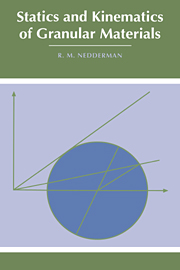Book contents
- Frontmatter
- Contents
- Notation
- 1 Introduction
- 2 The analysis of stress and strain rate
- 3 The ideal Coulomb material
- 4 Coulomb's method of wedges
- 5 The method of differential slices
- 6 Determination of physical properties
- 7 Exact stress analyses
- 8 Velocity distributions
- 9 The Conical yield function
- 10 The prediction of mass flow rate
- Set problems – chapters 2–10
- Appendices
- References and bibliography
- Index
9 - The Conical yield function
Published online by Cambridge University Press: 28 October 2009
- Frontmatter
- Contents
- Notation
- 1 Introduction
- 2 The analysis of stress and strain rate
- 3 The ideal Coulomb material
- 4 Coulomb's method of wedges
- 5 The method of differential slices
- 6 Determination of physical properties
- 7 Exact stress analyses
- 8 Velocity distributions
- 9 The Conical yield function
- 10 The prediction of mass flow rate
- Set problems – chapters 2–10
- Appendices
- References and bibliography
- Index
Summary
Introduction
All the analyses of stress and velocity distributions so far presented in this book have been based on the Coulomb yield criterion. It must be borne in mind that this is a mathematical model and not a universal truth. Therefore we must always check the predictions of this model by comparing them with experimental observations. The Coulomb yield criterion does seem to give an excellent prediction of the wall stresses for many materials but it does not follow from this that it is valid for all granular materials or for the prediction of other phenomena in the materials for which it gives reliable stress distributions. In particular we saw in §8.5 that the Coulomb model in conjunction with the assumption of radial flow, does not give a good prediction of the position of the stagnant zone boundary in core flow. It is not, however, clear whether the fault lies in the Coulomb criterion or in the assumption of radial flow.
Inspired by the failure of the analysis mentioned above, Jenike (1987) has recently revived interest in the Conical or Extended von Mises Failure Criterion. The purpose of this chapter is to present the background to this yield criterion and to establish the stress and velocity equations for radial flow of an incompressible material. The equations for a compressible material are given by Jenike. We will show that this criterion predicts markedly different velocity distributions from those resulting from the Coulomb criterion, but that the predicted stresses do not differ much.
- Type
- Chapter
- Information
- Statics and Kinematics of Granular Materials , pp. 277 - 291Publisher: Cambridge University PressPrint publication year: 1992

